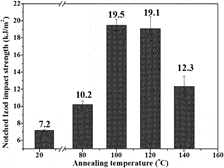Crossref Citations
This article has been cited by the following publications. This list is generated based on data provided by
Crossref.
Zhu, Wei
Yan, Chunze
Shi, Yunsong
Wen, Shifeng
Liu, Jie
and
Shi, Yusheng
2015.
Investigation into mechanical and microstructural properties of polypropylene manufactured by selective laser sintering in comparison with injection molding counterparts.
Materials & Design,
Vol. 82,
Issue. ,
p.
37.
Raasch, Jonathan
Ivey, Marcus
Aldrich, Daniel
Nobes, David S.
and
Ayranci, Cagri
2015.
Characterization of polyurethane shape memory polymer processed by material extrusion additive manufacturing.
Additive Manufacturing,
Vol. 8,
Issue. ,
p.
132.
Wang, Xiaomeng
Yin, Xiaogang
Wang, Lijun
Zhang, Chun
Gong, Wei
and
He, Li
2016.
Dynamic mechanical properties, crystallization behaviors, and low‐temperature performance of polypropylene random copolymer composites.
Journal of Applied Polymer Science,
Vol. 133,
Issue. 6,
Horváth, Zsuzsanna
Menyhárd, Alfréd
Doshev, Petar
Gahleitner, Markus
Friel, David
Varga, József
and
Pukánszky, Béla
2016.
Improvement of the impact strength of ethylene‐propylene random copolymers by nucleation.
Journal of Applied Polymer Science,
Vol. 133,
Issue. 34,
Zhu, Wei
Yan, Chunze
Shi, Yunsong
Wen, Shifeng
Han, Changjun
Cai, Chao
Liu, Jie
and
Shi, Yusheng
2016.
Study on the selective laser sintering of a low-isotacticity polypropylene powder.
Rapid Prototyping Journal,
Vol. 22,
Issue. 4,
p.
621.
Ivey, Marcus
Melenka, Garrett W.
Carey, Jason. P.
and
Ayranci, Cagri
2017.
Characterizing short-fiber-reinforced composites produced using additive manufacturing.
Advanced Manufacturing: Polymer & Composites Science,
Vol. 3,
Issue. 3,
p.
81.
Ma, Yulong
Wang, Xiaomeng
Liu, Wei
Gong, Wei
and
He, Li
2018.
Effects of Annealing Process on Crystallization and Low Temperature Resistance Properties of PP-R Composites.
Journal of Wuhan University of Technology-Mater. Sci. Ed.,
Vol. 33,
Issue. 4,
p.
855.
Ge, Qian
Ding, Lei
Zhang, Chao
Wu, Tong
Yang, Feng
and
Xiang, Ming
2019.
The effect of microstructure on the toughness of polypropylene random copolymer.
Polymer-Plastics Technology and Materials,
Vol. 58,
Issue. 14,
p.
1521.
Mulle, M.
Wafai, H.
Yudhanto, A.
Lubineau, G.
Yaldiz, R.
Schijve, W.
and
Verghese, N.
2019.
Influence of process-induced shrinkage and annealing on the thermomechanical behavior of glass fiber-reinforced polypropylene.
Composites Science and Technology,
Vol. 170,
Issue. ,
p.
183.
Wang, Ping
Qi, Yanli
and
Zhang, Jun
2019.
Sandwich-structure styrene-butadiene-styrene block copolymer (SBS)/polypropylene (PP) blends: The role of PP molecular weight.
Journal of Materials Research,
Vol. 34,
Issue. 6,
p.
982.
Peng, Wenli
Liu, Wenxia
Zhang, Wenxue
Li, Ke
Liu, Xin
Chen, Zhenbin
Tang, Zhenghua
and
Liu, Zhen
2019.
A novel approach of preparing zinc adipate as β-nucleating agent for polypropylene engineering.
Journal of Materials Research,
Vol. 34,
Issue. 21,
p.
3654.
Childress, Kimberly K.
Alim, Marvin D.
Hernandez, Juan J.
Stansbury, Jeffrey W.
and
Bowman, Christopher N.
2020.
Additive manufacture of lightly crosslinked semicrystalline thiol–enes for enhanced mechanical performance.
Polymer Chemistry,
Vol. 11,
Issue. 1,
p.
39.
Delli, Evangelia
Giliopoulos, Dimitrios
Bikiaris, Dimitrios N.
and
Chrissafis, Konstantinos
2021.
Fibre length and loading impact on the properties of glass fibre reinforced polypropylene random composites.
Composite Structures,
Vol. 263,
Issue. ,
p.
113678.
Wu, Yunqi
Ge, Qian
Yang, Feng
Wu, Tong
and
Xiang, Ming
2021.
Improving the low-temperature toughness of PPR pipe by compounding with PERT.
Journal of Polymer Research,
Vol. 28,
Issue. 4,
Silva dos Santos, Rayara
Poubel Mendonça da Silveira, Pedro Henrique
Cruz Bastos, Beatriz
do Nascimento da Conceição, Marceli
da Conceição Ribeiro, Roberto Carlos
and
Cruz Bastos, Daniele
2023.
Development of Environmentally Ecofriendly Composites Based on Polypropylene/Bahia Beige Waste: Effect of Reinforcement Content on Physical, Mechanical, Chemical, and Microstructural Properties.
Recent Progress in Materials,
Vol. 05,
Issue. 03,
p.
1.
Liu, Jingru
Lu, Bingkun
and
Xiao, Rui
2023.
Comparative study on annealing‐induced high‐impact toughness of linear and grafted polypropylene random copolymer.
Polymers for Advanced Technologies,
Vol. 34,
Issue. 5,
p.
1467.
Steele, Alexander G.
Etoundi, Apploinaire
and
Hunt, Alexander J.
2023.
Experimental Verification of Kinematics and Kinetics in a Biomimetic Bipedal Robot.
Journal of Mechanisms and Robotics,
Vol. 15,
Issue. 1,
Esmizadeh, Elnaz
Gupta, Arvind
Asrat, Samuel
and
Mekonnen, Tizazu H.
2024.
Crystallization and performance evolution of PHBV nanocomposites through annealing: The role of surface modification of CNCs.
Polymer,
Vol. 308,
Issue. ,
p.
127352.
Wang, Xing
Wang, Zhengze
Xiang, Siying
Peng, Minzhe
Li, Guangxian
and
Huang, Yajiang
2024.
Developing polypropylene copolymer powder with a wide sintering window for laser powder bed fusion via extrusion and in-blend annealing.
Additive Manufacturing,
Vol. 86,
Issue. ,
p.
104188.
Kulkarni, Sameer
Reuvers, Marie-Christine
Brepols, Tim
Reese, Stefanie
Johlitz, Michael
and
Lion, Alexander
2025.
Lectures Notes on Advanced Structured Materials 3.
Vol. 226,
Issue. ,
p.
275.



